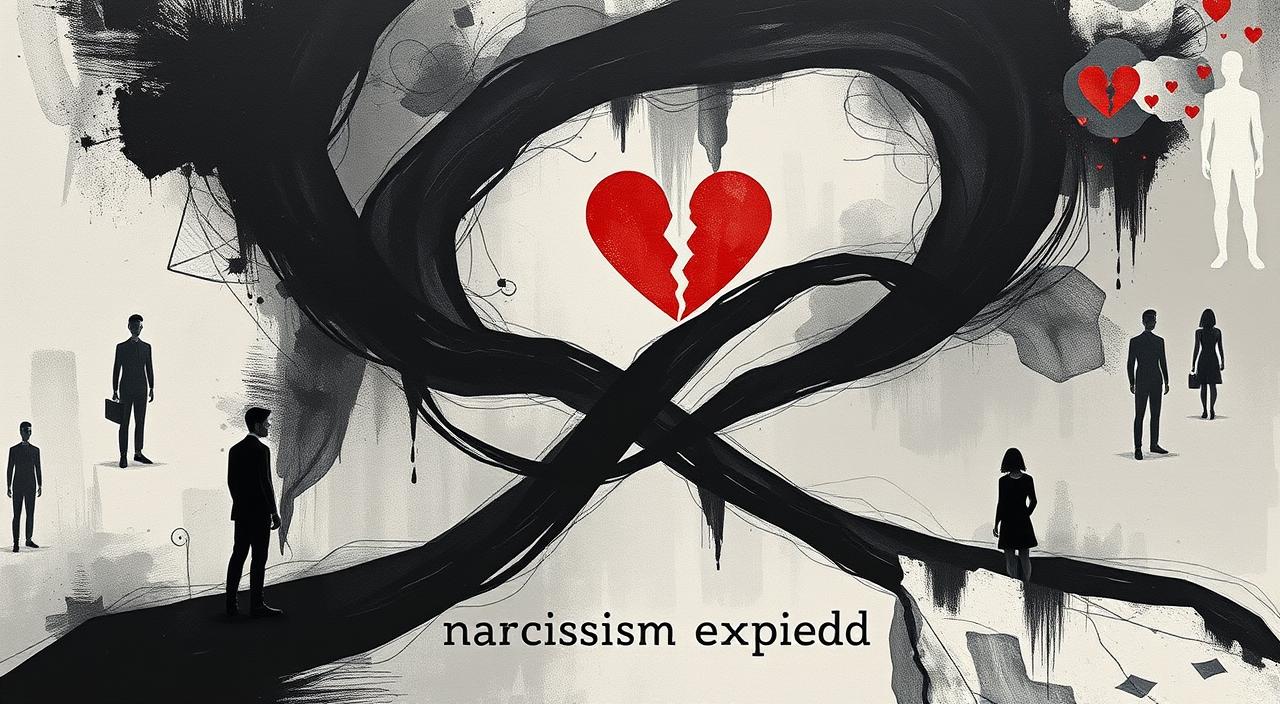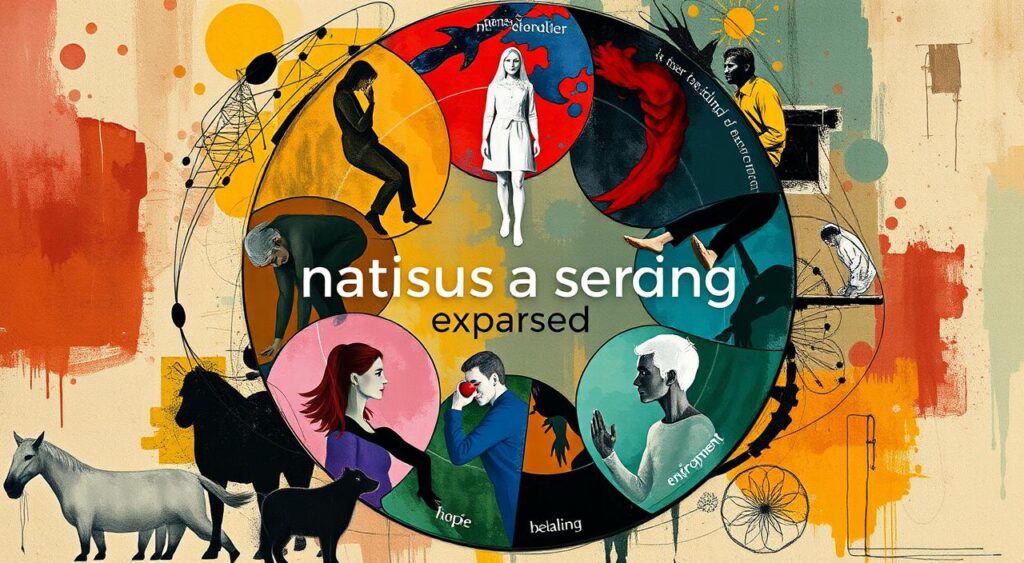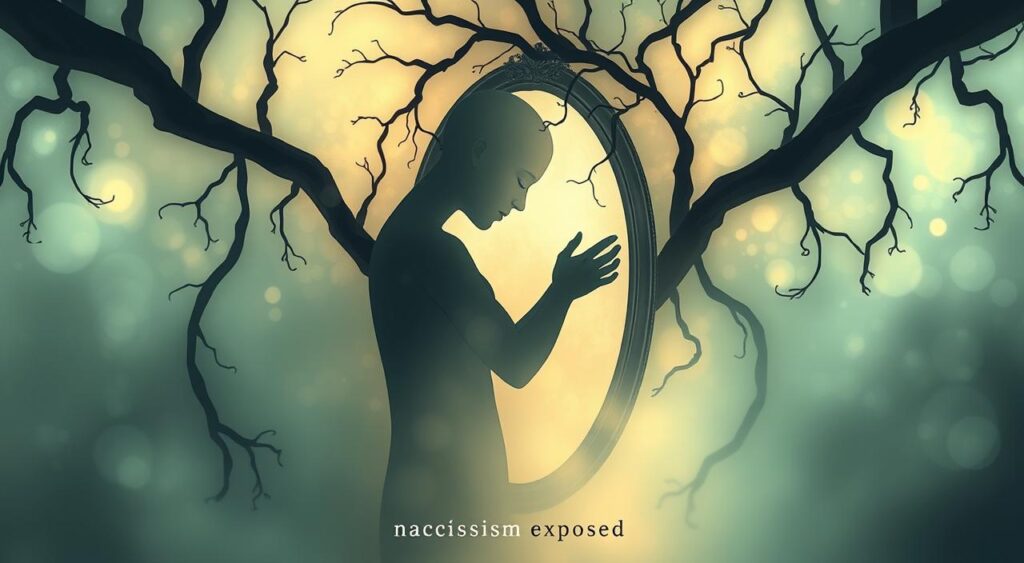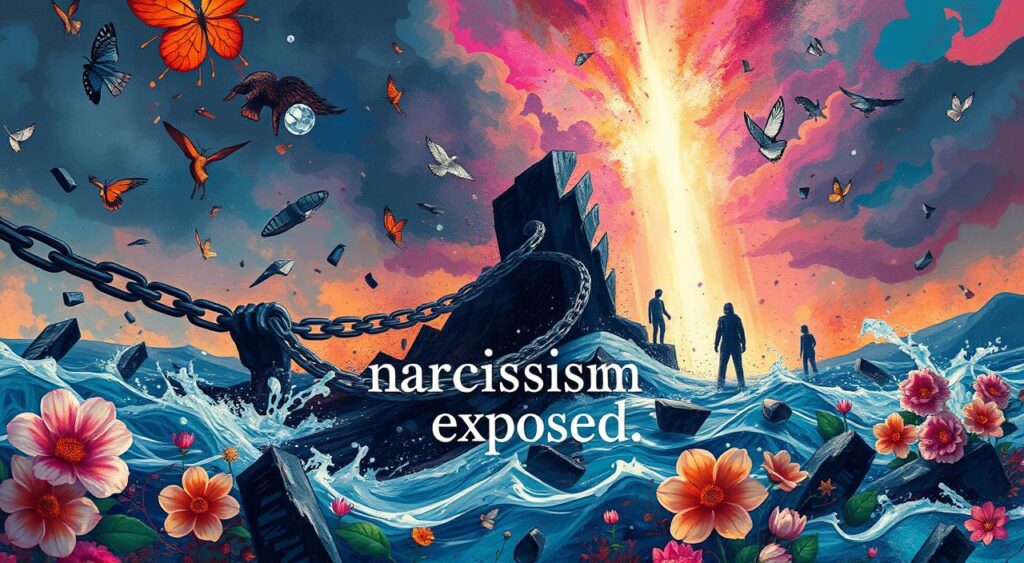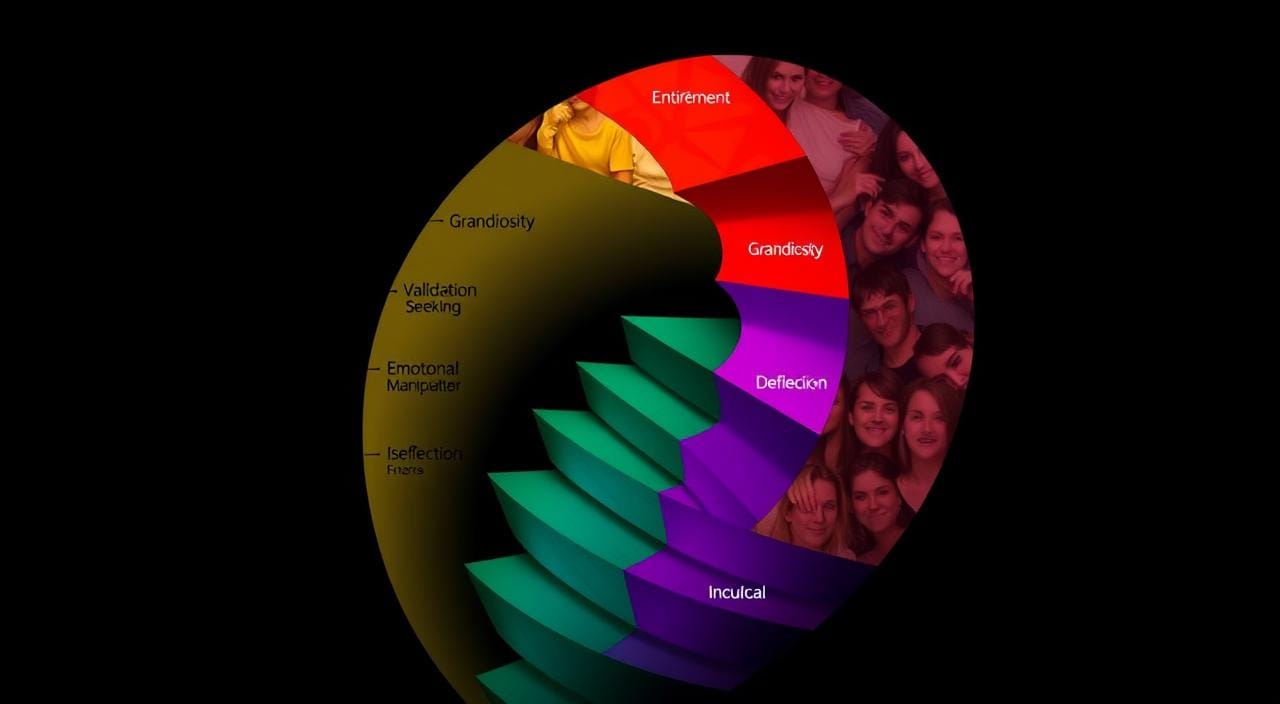Reflecting on my journey through a toxic relationship, I feel deep empathy for those who’ve gone through trauma bonding. This experience leaves deep emotional scars, but healing is possible. We’ll explore the stages of trauma bonding, showing how victims get trapped and how to escape.
Trauma bonding is like the Stockholm syndrome, where victims emotionally attach to their abusers1. This bond forms through manipulation, abuse, and occasional kindness, making victims feel trapped and lost. Knowing these stages helps spot the signs and start the journey to freedom.
Key Takeaways
- Trauma bonding is a complex psychological phenomenon that can lead to mental health deterioration and difficulty in breaking the cycle of abuse.
- The stages of trauma bonding include love bombing, trust and dependency building, criticism and degradation, gaslighting and confusion, loss of self, resignation and acceptance, and dissonance.
- Abusers employ manipulative tactics such as blaming the victim, denying actions, minimizing behaviors, and isolating the victim from others.
- Recognizing the signs of trauma bonding and seeking support are essential for breaking free and beginning the healing process.
- Professional help, self-care, and building healthy boundaries can aid in the recovery journey.
The stages of trauma bonding are complex, but understanding them helps us help ourselves and others. From love bombing to losing oneself, each phase traps victims deeper. By highlighting these patterns, we empower victims to spot the signs and start healing.
What is Trauma Bonding?
The Psychological Perspective
Trauma bonding is a harmful psychological response to abuse. It happens when a victim forms an unhealthy attachment to their abuser2. This is part of a cycle that includes abuse, manipulation, and occasional kindness2.
It’s like an addiction, as the victim craves the abuser’s kind moments between the pain2. The victim struggles to accept the abuser’s harmful actions and their kind words, deepening the bond2.
Dr. Patrick Carnes first talked about trauma bonding in 1997. He said it can happen in many kinds of relationships, not just romantic ones3. For example, it can be between parents and children, family members, or even between captives and their captors3.
Stockholm Syndrome is a type of trauma bonding. It’s when people held captive form a bond with their captors. This makes it hard for them to leave or report the abuse3.
People who were abused as children are more likely to form trauma bonds4. These bonds can also happen in adult relationships or other situations like domestic abuse or exploitation4.
Learning about trauma bonding helps us see how abusers manipulate their victims. Victims often feel a strong emotional connection with their abusers, making it hard to leave2. This cycle of abuse and kindness can lead to feeling trapped and dependent on the abuser2.
The 7 Stages of Trauma Bonding
The process of trauma bonding has seven distinct stages. Each stage deepens the emotional and psychological tie with the abuser. This cycle of abuse, known as trauma bonding, can happen in many relationships, like romantic ones, family ties, or even cult-like groups.5 Knowing these stages helps spot the signs of trauma bonding and how to escape.
- Love Bombing: Abusers use tactics like love bombing to control and exploit the victim. They shower the victim with lots of praise and affection at first5.
- Trust and Dependency Building: Abusers work on building trust and dependency. They share personal stories, create shared experiences, and promise loyalty and protection. This isolates the victim from friends and family5.
- Criticism and Degradation: The abuser then starts to criticize the victim. This lowers the victim’s confidence and makes them rely more on the abuser5.
- Gaslighting and Confusion: Abusers may use gaslighting to make the victim doubt their own reality and sanity5.
- Loss of Self: As abuse goes on, the victim’s self-worth drops. They feel helpless and focus on the abuser’s needs more than their own6.
- Resignation and Acceptance: The victim may feel resigned and accept their situation, even though it’s traumatic6.
- Dissonance and Potential Awakening: In the last stage, the victim starts to see the abuse clearly. They may begin to break free from the trauma bond6.
Trauma bonding is when a victim forms an emotional bond with an abuser after being exposed to trauma and manipulation6. Victims often feel intense emotions, become isolated, feel helpless, and focus on the abuser’s needs6. Knowing how trauma bonding affects victims can help us understand its impact on their mental health and ability to leave the relationship6.
Recognizing the stages of trauma bonding helps people understand the dynamics. It also shows how to escape this cycle of abuse. Looking at trauma bonding in different relationships can reveal how it plays out in various situations65.
Stage 1: Love Bombing
Characteristics and Examples
The love bombing stage often kicks off the trauma bonding cycle. Here, the abuser gives the victim lots of love, attention, and makes them feel like the perfect match7. This tactic is meant to grab the victim’s heart and make them think they’ve found their ideal partner7. Love bombing aims to tie the victim emotionally early on7. The abuser uses the victim’s need for love and approval to their advantage.
People caught in trauma bonding might see their abuser as very caring, always saying nice things, and ready to meet their needs8. This makes the victim ignore warning signs or accept bad behavior8. They’re drawn in by the abuser’s charm and the feeling of safety they offer.
“They were so affectionate and attentive in the beginning, always showering me with gifts and compliments. I had never felt so special and loved before. It’s only now that I realize it was all an act to manipulate me.”
The love bombing stage is key in trauma bonding. It makes the victim emotionally dependent on the abuser7. This phase prepares the ground for the next steps: building trust, criticism, and emotional control789.
Stage 2: Trust and Dependency Building
After the initial love bombing, the abuser starts to build trust and dependency in their partner. They use intermittent reinforcement to mix affection with neglect or abuse. This makes the victim rely on the abuser for emotional support10. They feel a strong attachment and fear of abandonment, making it hard to leave the relationship10.
The abuser uses tactics to make the victim feel uncertain and emotionally unstable. The victim hopes the relationship will go back to being loving, despite the abuse10. This is a key part of the trauma bonding process.
The trauma bond gets harder to break as the victim’s self-worth depends on the abuser’s approval. They fear being abandoned more and more11. At this stage, the victim doesn’t want to leave, even when the abuse gets worse. The abuser has a strong psychological grip on them.
Stage 3: Criticism and Degradation
Impact on Self-esteem
As the relationship moves forward, the abuser starts to criticize and degrade the victim. They might call it “jokes” or say it’s “for your own good.”12 This kind of criticism really hurts the victim’s self-esteem. They start to think they’re not good enough to be loved or respected outside the toxic relationship12. Feeling unworthy makes it hard for them to leave the relationship.
Victims often try to make excuses for the abuse. They might say it’s because of stress, outside pressures, or blame themselves for what happened13. Over time, they feel their self-esteem and self-worth dropping. They start to feel hopeless and helpless, taking in all the negative things the abuser says13.
The emotional abuse and degradation deeply affect the victim’s self-worth. They start to believe they don’t deserve good relationships or a happy life outside the toxic bond12. This stage is crucial. The victim’s self-esteem gets very fragile, making them more stuck in the abusive situation.
“The erosion of self-worth makes it even more challenging for the victim to leave the relationship.”
Stage 4: Gaslighting and Confusion
As the trauma bonding cycle moves forward, the abuser’s methods get more manipulative. Gaslighting, a form of psychological trickery, becomes common in this phase. The abuser denies their bad behavior or shifts blame to the victim, causing confusion and doubt14. Gaslighting is a sneaky way abusers try to make victims doubt their own reality, memory, and views14.
It’s important for victims to spot gaslighting. It shows the abuser is trying to control by messing with the victim’s view of the world14. Abusers use gaslighting to confuse and doubt the victim, doing things like denying facts, making the victim’s worries seem small, and changing stories to fit their own story14.
14 Gaslighting leads to a lot of confusion and doubt in the victim, which helps the abuser stay in control14. Victims start to need the abuser to tell them what’s real, letting the abuser manipulate them more and keep control.
The effects of gaslighting are huge. It chips away at the victim’s sense of self, causing a big loss of identity and self-esteem. Spotting gaslighting signs, like being constantly doubted, having your memories or experiences denied, or feeling always off-balance, is key to getting out of the trauma bond.
Recognizing Gaslighting
- Denial of facts or events: The abuser denies something that clearly happened or insists that the victim is “imagining things.”
- Trivializing concerns: The abuser dismisses the victim’s feelings or concerns as unimportant or “overreacting.”
- Shifting blame: The abuser blames the victim for their own abusive behavior, making the victim feel responsible for the abuse.
- Distorting reality: The abuser manipulates the victim’s perception of events, creating confusion and self-doubt.
- Isolating the victim: The abuser may cut off the victim’s support system, making them more dependent on the abuser.
Knowing the signs of gaslighting is the first step to taking back your sense of self and breaking free from the trauma bond. With awareness and support, victims can start to regain their confidence and end the cycle of abuse1514.
Stage 5: Loss of Self
Abuse, manipulation, and gaslighting can deeply affect a person, leading to a loss of their sense of self16. As the abuser gains more control, the victim may feel disconnected from their feelings, desires, and identity. They feel trapped in the trauma cycle16. This stage brings deep emotional pain and a loss of freedom, as the victim’s identity is shaped by the abuser’s needs17.
Victims may change who they are to please the abuser, trying to avoid more harm16. This self-change can cause a deep emotional gap, making it hard for them to find their true self. They feel lost and confused17.
This stage can also make victims emotionally dependent on the abuse and making up, not seeing life outside the toxic relationship16. They hold onto hope that the abuser will change or they can fix things, keeping them trapped17.
“The person I thought I was has been erased, and I no longer know who I am.”
Getting past this stage means a hard journey of finding oneself again. The victim must work to regain their identity and freedom. This is key to escaping abuse and taking back their life17.
Stage 6: Resignation and Acceptance
Going through the trauma bonding cycle is tough, and victims often feel stuck in the stage of resignation and acceptance12. They start to believe they deserve the bad treatment they get, leading to a sense of giving up and feeling loyal to their abuser12.
In this phase, coping strategies may appear, like denying the abuse or making excuses for the abuser’s actions12. The victim might think the occasional kind act from the abuser is more important than the pain it causes, strengthening the trauma bond12.
Coping Mechanisms
- Denial of the abuse
- Rationalization of the abuser’s behavior
- Internalizing beliefs of deserving poor treatment
This stage is crucial in the trauma bonding cycle, as it chips away at the victim’s self-worth and freedom12. Yet, it’s vital to understand this as a normal reaction to the abuser’s manipulation and control12. With support and resources, victims can start to question these beliefs and move towards healing and taking back their lives.
“Trauma bonding is like addiction, where the abused person craves the abuser’s occasional kindness amidst the pain, leading to emotional and psychological responses.”
Getting professional help and trying therapies like Trauma-Focused Cognitive Behavioral Therapy (CBT) can help in dealing with trauma bonding and escaping its cycle12. The path to healing is brave, but with support and kindness towards oneself, victims can regain their self-respect and start a journey of recovery151412.
Stage 7: Dissonance and Potential Awakening
The final stage of trauma bonding brings a growing feeling of dissonance18. This is when the reality of emotional abuse clashes with the deep feelings for the abuser. This conflict can push the victim to wake up, see the harm in the relationship, and look for help18.
Leaving a narcissistic relationship can make you feel like you need the abuser back, causing emotional ups and downs, and more dissonance19. You might find yourself torn between different thoughts and beliefs about the narcissist, leading to a lot of mental and emotional pain19. Feeling jealous and obsessed with the narcissist’s new relationships can also make you feel worse, adding to the dissonance19.
Asking for help from therapists, friends, or support groups is a key step towards healing and breaking free from trauma bonding18. This journey to healing means facing the truth about the abuse, overcoming fear of being alone, and finding your own strength19. It’s a tough road, but with the right support and will, you can move towards a happier, healthier life.
“The most potent weapon of the oppressor is the mind of the oppressed.” – Steve Biko
Breaking Free from Trauma Bonds
Steps to Healing and Recovery
Getting free from trauma bonds needs a plan that includes self-care, setting healthy limits, and getting help from experts. Studies show that people who faced trauma as kids might form trauma bonds as adults, with about 80% showing signs of this in their adult relationships.20 It’s key to take care of yourself and set clear boundaries.
Research says people in toxic relationships often find it hard to leave because of the strong emotional tie, with around 70% facing trouble breaking free.20 Working with therapists who know about trauma can really help you heal.
Therapy is a big help in ending trauma bonds, with about 60% of those who get counseling moving on to healthier relationships.20 Joining groups where people share their stories and support each other is also crucial for healing.
Setting boundaries is a big part of healing from trauma bonds, with data showing a 50% higher success rate in leaving bad relationships.20 Thinking deeply about your experiences can also help, with studies showing a 40% chance of changing negative thoughts and rewriting your story.20
Self-care is key to feeling better while healing from trauma bonds, with people who focus on self-compassion and care seeing a 30% drop in bad feelings.20 Doing things like journaling or talking to friends can help release trapped feelings, with a 25% boost in handling emotions better.20
Challenging negative thoughts helps in overcoming trauma bonds, with people who do this seeing a 35% increase in leaving bad relationships.20 Working on personal growth is also important for long-term healing, with research showing a 45% chance of breaking free and living a fulfilling life.20
“The journey to healing from trauma bonds is not easy, but it is a necessary step towards reclaiming your power and building a life of freedom and fulfillment.”
It’s common for people in trauma bonds to have been abused before, making it more likely they’ve experienced trauma.21 Finding support from people who don’t judge you is very important in overcoming trauma bonds21.
Learning about abusive patterns and keeping track of them is helpful, showing the power of awareness and records in escaping trauma bonds.21 Asking yourself questions and thinking deeply can really help you see things differently and move forward21.
Starting projects that don’t involve your partner is a good way to focus on yourself and grow.21 The text also talks about how some people in bad relationships might feel disconnected or struggle with their emotions, showing the deep effects of trauma bonds21.
It’s important to stop blaming yourself and avoid fights in relationships with trauma bonds.2120
Navigating the stages of trauma bonding
Understanding trauma bonding is key for those in abusive relationships or supporting them22. Dr. Patrick Carnes first talked about it in 199722. It’s not just about romantic relationships but also in family, parent-child, kidnapper-captive, and cult-like settings22.
Knowing the signs of trauma bonding can help people escape23. The cycle has seven stages, from love bombing to breaking free23. This cycle shows how victims get trapped23.
Getting help and having a strong support network is crucial for healing22. Sometimes, abusers are victims too, making things more complicated22. By understanding trauma bonding, people can start to heal and make new, healthy connections22.
Recovery is not easy, and it’s important to be kind, patient, and seek help23. Taking care of yourself, setting boundaries, and healing can help you regain your strength23.
If you’re dealing with trauma bonding or supporting someone, knowing the dynamics and getting professional help are key steps to a better life.
Self-care and Boundaries
Healing from an abusive relationship starts with self-care and setting clear boundaries24. It’s important to understand the effects of trauma and abuse to move forward24. Doing things that make you feel good can help you regain your self-worth and strength24. Learning new skills and building inner strength also helps survivors of abuse24.
Setting boundaries is key to taking back control of your life and making sure your needs are met24. It’s important for breaking free from a toxic bond and keeping yourself safe24. Healthy relationships are built on respect, trust, and support, which are crucial for healing from trauma24.
Trauma bonding can cause serious mental health issues like depression, anxiety, and PTSD25. It can also lead to physical health problems such as chronic pain, sleep issues, and stress-related conditions25. Trauma bonding can greatly lower the quality of life and have lasting effects25.
“Generational trauma, the passing down of trauma from one generation to the next, can greatly affect trauma bonding.”25
Rebuilding your self-worth is a big part of getting better. Trauma bonds create a strong emotional in bad or abusive relationships, marked by cycles of abuse and positive moments24. Breaking free from this bond is hard but necessary to take back your life24.
- After an abusive relationship, focusing on self-discovery and setting goals is key to finding yourself again26.
- Self-care, like journaling, mindfulness, positive thinking, and affirmations, is important for healing from a trauma bond26.
Trauma bonding can cause emotional ups and downs, feeling lonely, wanting the abuser’s attention, trouble setting boundaries, blaming yourself, and thinking in a way that’s not fair26.
Talking to a therapist or counselor is crucial for dealing with trauma bonding25. They offer support, advice, and tools to help you move past the abuse25. Therapy is key for making sense of your feelings, working through them, and learning how to cope26. Joining support groups or building a strong support network is also helpful for those healing from toxic relationships26.
Setting healthy boundaries and taking care of yourself are key steps in healing and taking back your life. By focusing on your well-being and setting limits, you can break free from the trauma bond and rebuild your self-worth24.
Professional Help and Therapy
Getting help from mental health experts is key to healing from trauma bonding. Therapists who focus on trauma care offer a safe place to work through feelings. They help you understand the trauma bond and find ways to move on. Therapies like Trauma-Focused Cognitive Behavioral Therapy (CBT) are very helpful. Joining support groups also helps, where you can share stories and feel supported27.
Research shows trauma bonding isn’t just about romantic relationships. It can happen in families, at work, or in religious groups28. Studies reveal how trauma changes the brain, affecting how we connect and separate28. Therapies like Cognitive Behavioral Therapy (CBT) and Dialectical Behavioral Therapy (DBT) can help break free from trauma bonds28.
- Support groups are great for people in trauma bonded situations. They offer a place for talking openly and sharing stories28.
- Self-care activities like working out, writing in a journal, and enjoying hobbies help people leave trauma bonds behind28.
- Creating healthy relationships and learning to communicate well are key to healing from trauma bonding28.
The National Institute of Mental Health sees trauma bonding as a big part of abuse29. People in these situations often feel scared, anxious, sad, or confused29. Narcissistic abuse is common in these relationships, and the abuser might act narcissistic29.
“Understanding the 7 stages of trauma bonding can help in recognizing and overcoming trauma bonds.”
With professional help and support, you can work through trauma bonding.
Embracing the Journey
The path to healing from trauma is tough, but it’s full of chances for growth and personal transformation. Embracing this journey means facing your fears, accepting change, and slowly building your self-worth30. Healing isn’t a goal, but a process that needs patience, kindness to yourself, and faith in your strength30.
Every step you take brings you closer to a life full of health and happiness, free from abuse’s shadows30. This path is hard, but it’s a chance to grow resilience and personal growth30. By being kind to yourself in recovery, you can see the progress you make, no matter how small30.
You’re not alone on this journey. Reach out to loved ones, join groups, or see a therapist who knows about trauma3031. With support, you can work through trauma bonding and come out stronger31.
Face the challenges, celebrate your victories, and believe in your power to heal32. This journey is hard, but it will lead you to a place of deep self-knowledge, power, and healing from trauma32.
“The journey of a thousand miles begins with a single step.” – Lao Tzu
Your First Step Towards Healing
Starting your healing journey from trauma bonding is easy. Just a call or a click away, Counseling Associates for Well-Being is ready to help. They focus on trauma bonding, offering support and strategies to overcome emotional manipulation and fear33. Their team of therapists will guide you, from understanding abuse to building healthy relationships34.
Asking for help is a brave step towards getting your life back. At Counseling Associates, you’ll find a safe place to talk about your experiences and feelings33. They help you develop skills to break free from the trauma bond33. Their approach is full of compassion, helping you see your past and yourself in a new light33.
Don’t wait to take that first step. Call Counseling Associates for your first consultation today. Start your healing journey towards a life free from trauma bonding33. You deserve it, and the professionals at Counseling Associates will support you all the way34.
“The first step towards healing is the hardest, but with the right support, you can reclaim your power and break free from the trauma bond.”
- Reach out to Counseling Associates for Well-Being to schedule your initial consultation.
- Engage in a safe, empathetic environment to explore your experiences and emotions.
- Develop the skills and strategies needed to establish healthy boundaries and relationships.
- Embrace the process of rewriting your internal narrative and cultivating self-worth.
- Commit to your healing journey and take the first step towards a life free from trauma bonding.
Conclusion
Understanding trauma bonding and its stages is key to breaking free from abusive relationships. The healing journey is tough but promising. It helps you find your true self and build better relationships35.
Self-care, professional help, and embracing healing give you the power to move past an abusive past. You can build a future filled with respect, care, and true happiness36. The recovery path isn’t straight, but you can take steps to regain your freedom and form deep connections37.
You’re not alone in this fight. Counseling, support groups, and hotlines offer the help you need to break the trauma cycle and take back your life35. With determination and kindness towards yourself, you can face challenges and grow. You’re ready for a future full of hope and new chances36.
FAQ
What is trauma bonding?
Trauma bonding is when a person feels a strong emotional tie with their abuser. This happens because of a mix of abuse, manipulation, and sometimes affection.
What are the stages of trauma bonding?
Trauma bonding has 7 stages: love bombing, building trust and dependency, criticism, gaslighting, losing self, accepting the situation, and feeling confused and possibly waking up.
How does the love bombing stage work?
In love bombing, the abuser shows a lot of love and attention to the victim. This is a way to trap the victim and make them think they’ve found the perfect partner.
What is the impact of criticism and degradation in trauma bonding?
Being constantly criticized and belittled by the abuser hurts the victim’s self-esteem. They start to think they don’t deserve love or respect outside the relationship. This makes leaving harder.
How does gaslighting contribute to trauma bonding?
Gaslighting makes the victim doubt themselves and feel confused. The abuser denies being abusive or blames the victim, changing what the victim thinks is real.
What are the signs of the loss of self stage in trauma bonding?
In this stage, victims lose touch with their feelings, desires, and identity. They feel stuck in the abusive cycle with no escape.
How can someone break free from trauma bonds?
To break free, focus on self-care, set healthy boundaries, get professional help, and join support groups focused on trauma.
Why is seeking professional help important in healing from trauma bonding?
Working with therapists who understand trauma can help a lot. They offer guidance and support. Therapies like Trauma-Focused Cognitive Behavioral Therapy (CBT) are very helpful.
Source Links
- 7 Stages of Trauma Bonding and How to Break the Cycle – https://psychcentral.com/relationships/breaking-the-deceptive-and-toxic-cycle-of-trauma-bonding
- Trauma Bonding Isn’t Bonding Over Shared Trauma—It’s More Like Stockholm Syndrome – https://www.verywellmind.com/trauma-bonding-5207136
- The 7 Stages of Trauma Bonding – https://www.sequoiabehavioralhealth.org/blogs/7-stages-of-trauma-bonding
- Trauma Bonding: What It Is and How to Heal – https://www.verywellhealth.com/trauma-bonding-5210779
- Understanding the 7 Stages of Trauma Bonding – https://socalsunrise.com/trauma-bonding/understanding-the-7-stages-of-trauma-bonding/
- Understanding Trauma Bonding: 7 Stages and 10 Signs – https://livewelltalk.medium.com/7-stages-and-10-signs-of-trauma-bonding-3ef38a3b9f2f
- Seven Key Stages of Trauma Bonding – Optimum Joy – https://optimumjoy.com/blog/seven-key-stages-of-trauma-bonding/
- What Are The 7 Stages Of Trauma Bonding? – Dear Media – https://dearmedia.com/stages-of-trauma-bonding/
- 7 Stages Of Trauma Bonding – https://grace-being.com/love-relationships/7-stages-of-trauma-bonding/
- 7 Stages of Trauma Bonding in a Relationship and How to Handle – https://www.marriage.com/advice/mental-health/seven-stages-of-trauma-bonding/
- What are the 7 Stages of Trauma Bonding? | Get Support Today – https://icarusbehavioralhealthnevada.com/7-stages-of-trauma-bonding/
- When Love Hurts: The 7 Stages of Trauma Bonding – https://ca4wellbeing.com/7-stages-of-trauma-bonding/
- Trauma Bonding: Signs, Stages & Recovery | D’Amore – https://damorementalhealth.com/trauma-bonding-signs-stages-and-recovery/
- 7 Stages of Trauma Bonding — Meridian Counseling – https://www.meridian-counseling.com/blog/7-stages-of-trauma-bonding
- The 7 Stages of Trauma Bonding – Attachment Project – https://www.attachmentproject.com/psychology/trauma-bonding/7-stages/
- Understanding the 7 Stages of Trauma Bonding – https://jessicaknightcoaching.medium.com/understanding-the-7-stages-of-trauma-bonding-954e3002b446
- 7 Stages of Trauma Bonding – https://www.linkedin.com/pulse/7-stages-trauma-bonding-pranav-kumar-zawef
- Traumatic Bonding – https://victimsofpsychopaths.wordpress.com/traumatic-bonding/
- Understanding Trauma Bond Withdrawal Symptoms – https://grace-being.com/love-relationships/trauma-bond-withdrawal-symptoms/
- How to Break Free From a Trauma Bond – https://www.psychologytoday.com/us/blog/the-angry-therapist/202310/how-to-break-free-from-a-trauma-bond
- Traumatic Bonding – How to Break Free of Trauma Bonds – https://www.harleytherapy.co.uk/counselling/traumatic-bonding-break-trauma-bonds.htm
- 7 Stages of Trauma Bonding – Crossroads Antigua – https://crossroadsantigua.org/7-stages-of-trauma-bonding/
- 7 Stages of Trauma Bond | Uncover Mental Health Counseling – https://uncovercounseling.com/blog/7-stages-of-trauma-bond/
- How to Break a Trauma Bond | Charlie Health – https://www.charliehealth.com/areas-of-care/trauma/how-to-break-a-trauma-bond
- The Psychology of Trauma Bonding | Psyclarity Health – https://psyclarityhealth.com/the-psychology-of-trauma-bonding/
- Trauma bonding: How to identify it & 4 strategies for healing – https://www.rula.com/blog/trauma-bonding/
- Understanding Trauma Bonding: Effects & Coping Strategies | Thriveworks – https://thriveworks.com/help-with/trauma/trauma-bonding/
- How to Heal from a Trauma Bond Relationship – Mental Health – https://apn.com/resources/how-to-heal-from-a-trauma-bond-relationship/
- The 7 Stages of Trauma Bonding | Icarus in NM | 24/7 Help – https://icarusbehavioralhealth.com/ptsd-inpatient-treatment/stages-of-trauma-bonding/
- Trauma Bonding: Definition, Stages, & Recovery – https://www.robinrecovery.com/post/trauma-bonding-definition-stages-and-recovery
- Understanding Trauma Bonding: The Complex Ties to Abusive Relationships – https://www.wrightpathcounseling.com/post/understanding-trauma-bonding-the-complex-ties-to-abusive-relationships
- Trauma Bonding Understanding the Power of Abusive Relationships – https://beatanxiety.me/trauma-bonding-understanding-the-power-of-abusive-relationships/
- The First Step in Healing My Trauma Was Acknowledging It – https://www.psychologytoday.com/us/blog/set-yourself-free/202403/the-first-step-in-healing-my-trauma-was-acknowledging-it
- What Is Trauma Bonding? Signs and How To Cope – https://health.clevelandclinic.org/trauma-bonding
- Conclusion – Athens Now Alabama – https://athensnowal.net/trauma-bonding-conclusion/
- BrightPoint MD – 5 stages of trauma recovery 2023 – https://www.brightpoint-md.com/health-conditions/breaking-the-chains-a-comprehensive-look-at-trauma-bond-recovery/
- Trauma Bonding: Definition, Stages & Treatment | Zinnia Health – https://zinniahealth.com/mental-health/blog/trauma-bonding
